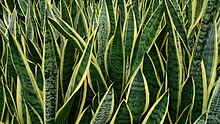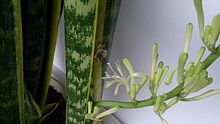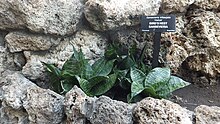Dracaena trifasciata
| Snake plant | |
|---|---|

| |
| A variegated cultivar, 'Laurentii' | |

| |
| Wild plant with fruits | |
| Scientific classification | |
| Kingdom: | Plantae |
| Clade: | Tracheophytes |
| Clade: | Angiosperms |
| Clade: | Monocots |
| Order: | Asparagales |
| Family: | Asparagaceae |
| Subfamily: | Nolinoideae |
| Genus: | Dracaena |
| Species: | D. trifasciata
|
| Binomial name | |
| Dracaena trifasciata (Prain) Mabb.[1]
| |
| Synonyms[1] | |
| |
Dracaena trifasciata is a species of flowering plant in the family Asparagaceae, native to tropical West Africa from Nigeria east to the Congo. It is most commonly known as the snake plant, Saint George's sword, mother-in-law's tongue, and viper's bowstring hemp, among other names.[2] Until 2017, it was known under the synonym Sansevieria trifasciata.[1]
Description[]
It is an evergreen perennial plant forming dense stands, spreading by way of its creeping rhizome, which is sometimes above ground, sometimes underground. Its stiff leaves grow vertically from a basal rosette. Mature leaves are dark green with light gray-green cross-banding and usually range from 70–90 centimetres (2.3–3.0 ft) long and 5–6 centimetres (2.0–2.4 in) wide, though it can reach heights above 2 m (6 ft) in optimal conditions.[3]
The specific epithet trifasciata means "three bundles".[4]
The plant exchanges oxygen and carbon dioxide using the crassulacean acid metabolism process, which allows them to withstand drought. The microscopic pores on the plant's leaves, called the stomata and used to exchange gases, are only opened at night to prevent water from escaping via evaporation in the hot sun. It is a weed in some parts of northern Australia.[5]
Common names[]
Dracaena trifasciata is commonly called "mother-in-law's tongue", "Saint George's sword" or "snake plant", because of the shape and sharp margins of its leaves.[2] It is also known as the "viper's bowstring hemp", because it is one of the sources for plant fibers used to make bowstrings.[6]
Cultivation and uses[]
Like some other members of its genus, D. trifasciata yields bowstring hemp, a strong plant fiber once used to make bowstrings.


It is now used predominantly as an ornamental plant, outdoors in warmer climates, and indoors as a houseplant in cooler climates. It is popular as a houseplant because it is tolerant of low light levels and irregular watering; during winter it needs only one watering every couple of months. It will rot easily if overwatered.[7] It is commonly recommended to beginners interested in cultivating houseplants for its easy care.[8]


The NASA Clean Air Study found D. trifasciata has potential to filter indoor air, removing 4 of the 5 main toxins involved in the effects of sick building syndrome.[9] However, its rate of filtration is too slow for practical indoor use.[10]
It can be propagated by cuttings or by dividing the rhizome. The first method has the disadvantage that the variegation will be lost.[11]
D. trifasciata is considered by some authorities as a potential weed in Australia, although widely used as an ornamental, in both the tropics outdoors in both pots and garden beds and as an indoor plant in temperate areas.[12]
The plant contains saponins which are mildly toxic to dogs and cats and can lead to gastrointestinal upset if consumed.[13]
Varieties and cultivars[]
Numerous cultivars have been selected, many of them for variegated foliage with yellow or silvery-white stripes on the leaf margins. Popular cultivars include 'Compacta', 'Goldiana', 'Hahnii', 'Laurentii', 'Silbersee', and 'Silver Hahnii'. 'Hahnii' was discovered in 1939 by William W. Smith, Jr. in the Crescent Nursery Company, New Orleans, Louisiana. The 1941 patent was assigned to Sylvan Frank Hahn, Pittsburgh, Pennsylvania.[14]
The variety D. trifasciata var. laurentii,[15] together with the cultivars 'Bantel's Sensation'[16] and 'Golden Hahni'[17] have gained the Royal Horticultural Society's Award of Garden Merit.[18]
Cultural significance[]
In its native range in Africa, a yellow-tipped cultivar is associated with Oya, the female Orisha of storms. In Nigeria it is commonly linked with Ogun, the Orisha of war, and is used in rituals to remove the evil eye.[19] In Brazil its common name Espada de São Jorge links it to Saint George, who by syncretism is also associated with Orisha Ogun.[20]
References[]
- ^ Jump up to: a b c "Sansevieria trifasciata". World Checklist of Selected Plant Families. Royal Botanic Gardens, Kew. Retrieved 2020-02-18.
- ^ Jump up to: a b "Sansevieria trifasciata". Stellenbosch University Botanical Garden. 20 July 2019. Retrieved 30 July 2019.
- ^ "Snake Plant". Better Homes & Gardens. Retrieved 2021-06-15.
- ^ Harrison, Lorraine (2012). RHS Latin for gardeners. United Kingdom: Mitchell Beazley. p. 224. ISBN 9781845337315.
- ^ "mother-in-law's tongue | Weed Identification – Brisbane City Council". weeds.brisbane.qld.gov.au. Retrieved 23 June 2019.
- ^ "Sansevieria trifasciata". Natural Resources Conservation Service PLANTS Database. USDA. Retrieved 30 October 2015.
- ^ "Mother-in-Law's Tongue or Snake Plant". Retrieved 2010-03-04.
- ^ www.themanual.com https://www.themanual.com/culture/easy-plants-for-beginners/. Retrieved 2020-05-17. Missing or empty
|title=(help) - ^ BC Wolverton; WL Douglas; K Bounds (July 1989). A study of interior landscape plants for indoor air pollution abatement (PDF) (Report). NASA. NASA-TM-108061.
- ^ Cummings, Bryan E.; Waring, Michael S. (2019-11-06). "Potted plants do not improve indoor air quality: a review and analysis of reported VOC removal efficiencies". Journal of Exposure Science & Environmental Epidemiology. 30 (2): 253–261. doi:10.1038/s41370-019-0175-9. ISSN 1559-064X. PMID 31695112.
- ^ "Sansevieria Production Guide".
- ^ S. Csurhes and R. Edwards (1998). "Potential environmental weeds in Australia: Candidate species for preventative control" (PDF). Queensland Department of Natural Resources. Archived from the original (PDF) on October 10, 2007. Retrieved March 26, 2013.
- ^ "Mother-in-Law's Tongue". ASPCA.
- ^ Smith, William Walter. "Sansevieria". Plant Patent 470. United States Patent Office. Retrieved March 26, 2013.
- ^ "Sansevieria trifasciata var. laurentii". RHS. Retrieved 18 February 2019.
- ^ "Sansevieria trifasciata 'Bantel's Sensation'". RHS. Retrieved 18 February 2019.
- ^ "Sansevierie trifasciata 'Golden Hahni'". RHS. Retrieved 18 February 2019.
- ^ "AGM Plants - Ornamental" (PDF). Royal Horticultural Society. July 2017. p. 94. Retrieved 28 October 2018.
- ^ "A LA RECHERCHE DS PLANTES PERDUES, Les plante reouvées par les descendants culturels des Yoruba au Brésil" (in French). 1995-07-01. Retrieved 2020-08-14.
- ^ "How to Carry Out a Democratic Ethnobotanical Study". 2019-12-04. Archived from the original on 2020-08-14. Retrieved 2020-08-14.
External links[]
| Wikimedia Commons has media related to Sansevieria trifasciata. |
- Dracaena (plant)
- Flora of West Tropical Africa
- Garden plants of Africa
- House plants
- Low light plants